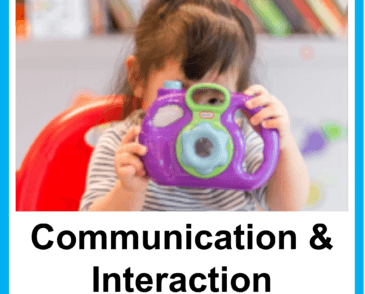

Last Updated - February 5, 2025
Each unique child presents in their own way – Early Years – Communication and Interaction
All children will develop their Speech, Language and Communication (SLC) skills at their own pace with their unique patterns of development.
Children’s back-and-forth interactions from an early age form the foundations for language and cognitive development. The number and quality of the conversations they have with adults and peers throughout the day in a language-rich environment is crucial. By commenting on what children are interested in or doing, and echoing back what they say with new vocabulary added, practitioners will build children’s language effectively.
Reading frequently to children, and engaging them actively in stories, non-fiction, rhymes and poems, and then providing them with extensive opportunities to use and embed new words in a range of contexts, will give children the opportunity to thrive.
Through conversation, storytelling and role play, where children share their ideas with support and modelling from their teacher, and sensitive questioning that invites them to elaborate, children become comfortable using a rich range of vocabulary and language structures.
Here are some key responses that you may observe:
- The child may make fleeting eye gaze towards an adult talking or being within their presence.
- The child may imitate familiar gestures e.g. banging table, shaking rattle.
- The child may squeeze or shake a toy to produce a sound in imitation.
- The child may respond to gestures with gestures.
- The child may look towards an object/action or person when it is named/signed/or shown in a picture.
- The child may find responding to simple, single-step verbal instructions confusing without the support of visual communication.
- The child may remain mainly silent with limited, or no use of, vocalisations or babble.
- The child may express themselves using e.g. non-verbal actions, screams or smiles.
- The child may use voice and gesture in response to music and song.
- The child use voice and gesture to attract attention or refuse.
- The child may lead adults to things they want rather than vocalising or pointing.
- The child may play mainly silently.
- The child may laugh, chuckle or squeal aloud in play.
- The child may attend to 2 objects nearby and indicate a preference by reaching out.
- The child may use a few vocalisation or signs that approximate words understood by familiar adults.
- The child may make a choice when shown 2 named and offered items.
- Responds to repetitive words said in context e.g. ‘gone’ ‘bye-bye’, ‘stop’.
- The child may begin to follow one step verbal directions with gestures / visual cues.
- The child may give familiar objects on request.
- The child may respond to simple gestures and words such as ‘up’ and ‘down’ by moving their body to show you they understand.
- The child may show anticipation of actions of familiar rhymes such as clapping, smiling or vocalising.
- The child may have fleeting attention, moving quickly from one activity to another.
- The child may show frequent bursts of frustration when their needs and wants are not understood.
- The child’s play skills may be repetitive and limited in range.
- The child may be communicative but not intelligible to familiar adults and peers.
- The child may be more interested in other activities or looking at books alone rather than showing an interest in simple stories shared as a group.
- The child may find following 2 step verbal requests confusing or difficult to remember.
- The child may show confusion and respond unexpectedly when asked questions (who, what & where).
- The child may be easily distracted by what is going on around them and lose interest quickly in the primary activity.
- The child may by using single word or simple 2 word utterances that appears very immature for their age.
- The child may need rhyme and song to be repetitive and sung slowly, to join in with actions and words and remember the sequence.
- The child may enjoy songs and rhymes through body rocking or vocalising.
- The child may use other ways of communicating other than talk to express their feelings, wants and needs with others e.g. body language, facial expression or unwanted behaviours.
- The child may talk about the things that interest them only regardless of the listeners’ attentiveness or interest.
- The child moves away from group activities involving song and rhyme.
- The child may show interest in a simple picture book story on their own terms e.g. controlling the page turning, wanting to sit by themselves.
View and/or download the Torbay Early Years Toolkit here: Torbay Early Years Graduated Approach Toolkit – Family Hub
